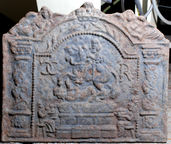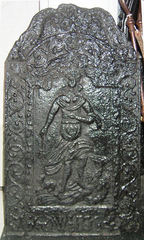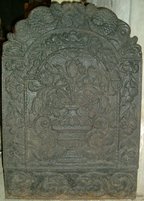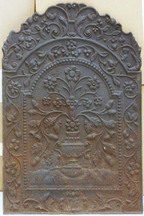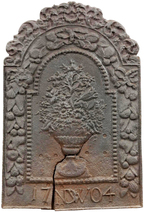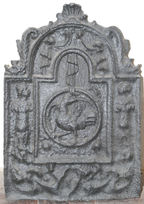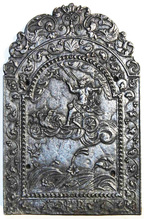-
928
Description: Carved wooden fireback pattern. Arched rectangular central panel with astragal and fillet edging; Phaëton riding Apollo’s chariot across the skies, the sun to the left behind clouds, a lion on ground below, between two trees; arched rectangular border with fillet edging; trailing convolvulus leaves surround the central panel.
Notes: The illustration upon which the design has been based has not been identified, save that it figures in book II of Ovid's Metamorphoses. The convolvulus border is a common feature of this series of firebacks; given to the Sussex Archaeological Society by the Rev. J. Bickersteth.
- Decoration tags:
- 'Dutch' (shape)
- fillet (edging)
- whole carved pattern
- planklines
- pictorial
- mythological
- animals
- humans
- objects
Manufactured: in the early-18th century in England.
Current location: Anne of Cleves House, Southover High Street, Lewes, East Sussex, England.
(part of the Sussex Archaeological Society museum group)
Citation: Baines, J. M., 1958, Wealden Firebacks (Hastings Museum).
Citation: Dawson, C., 1903, 'Sussex Iron Work and Pottery', Sussex Archaeological Collections, 46, pp. 1-54.
- Attached to series:
- Patterns
- TAN series
-
464
Description: Arched rectangular shaped central panel, bead edging (top and sides), pedestal bearing a supine male figure with headband being trampled by a horse, facing left, mounted by a rider with long hair, facing to the front; on each side of the plinth is a seated figure with a basket of fruit; the inscription is split either side of the horse; arched rectangular shaped border, fillet edging, on each side a Solomonic column with vine decoration; in the arch, symmetrical parallel curved lines intertwined beneath a crown; on top of each shoulder of the plate a female figure in repose.
Notes: The equestrian figure is derived from the statue of Charles II erected in Stocks Market, London, in 1672. Originally to be of Jan Sobieski, later king of Poland, riding down a Tatar, it was altered to represent Charles, and the Tatar’s face was changed to that of Oliver Cromwell; the statue attracted a fair degree of derision. The 'CC' monogram is likely to be for Charles and Catherine (of Braganza). The statue is now at Newby Hall, near Ripon, North Yorkshire. Another version (no. 280), probably by the same pattern-maker, is dated 1674 and has altered initials.
Copies of this fireback are known.
Inscription: CC [interlocked, and the first reversed] R
- Decoration tags:
- 'Dutch' (shape)
- ovolo (edging)
- whole carved pattern
- individual letters
- pictorial
- historical
- text
Manufactured: in the mid- to late-17th century in England.
Current location: in private hands, Little Horsted, East Sussex, England.
- Attached to series:
- Carolean 'Dutch' series
- Commemorative firebacks
-
1005
Description: Arched rectangular central panel within double fillet foliate edging; pictorial scene of a crudely modelled clothed female figure holding a wand? in the right hand; indistinct pictorial element to bottom right; arched rectangular border with fillet edging containing repeated swirled decoration; on top, two mirrored sea monsters.
Notes: A crude pastiche of the 'Dutch' style of fireback; the central figure may be Hera with a peacock. Formerly at the Raleigh Trevelyan estate, St Cadix, Cornwall.
Inscription: WHC[?]
- Decoration tags:
- 'Dutch' (shape)
- fillet (edging)
- whole carved pattern
- pictorial
- mythological
- text
- animals
- humans
Manufactured: in the early-18th century in England.
Current location: Deja Vu Antiques, 31 Fore Street, Lostwithiel, Cornwall, England.
- Attached to series:
- British 'Dutch' style firebacks
-
476
Description: Arched rectangular central panel with bead edging; pictorial scene of a stork dipping its beak into a tall pot, a fox close by, a tree to the right; arched rectangular border with fillet edging; at top, a double clasp with descending ribbon on each side from which are suspended, via rings, a shield, trumpets and an armoured torso; at the bottom, an oval cartouche between two blocks; on the top, a central pomegranate between two descending sea serpents, and a pomegranate on each shoulder of the plate.
Notes: The scene illustrates one of Aesop's Fables.
- Decoration tags:
- 'Dutch' (shape)
- fillet (edging)
- whole carved pattern
- pictorial
- mythological
- animals
- objects
Manufactured: in the mid- to late-17th century in the Siegerland area of Germany.
Current location: Maidstone Museum, St Faith's Street, Maidstone, Kent, England.
(part of the Maidstone Museum museum group)
- Attached to series:
- 'Dutch' Miscellaneous Firebacks
-
479
Description: Arched rectangular central panel with bead-and-pellet edging; on a ground between two plants, a gadrooned flower vase with two, scrolled handles, tulips and other flowers issuing from the narrow neck; arched rectangular border with fillet edging; mirrored descending flower swags; along a rectangular bottom panel with fillet edging a symmetrical arrangement of swirled foliage; on top, two mirrored sea serpents.
Notes: The presence of tulips suggest a Dutch origin for the pattern of this fireback, although the presence of several examples in England suggest that it was produced here rather than on the Continent.
Copies of this fireback are known.
Manufactured: in the late-17th century in England.
Current location: Maidstone Museum, St Faith's Street, Maidstone, Kent, England.
(part of the Maidstone Museum museum group)
- Attached to series:
- Flower Vase 'Dutch' types
- British 'Dutch' style firebacks
-
1170
Description: Arched rectangular central panel with bead on broad fillet edging; two-handled vase standing on a ground, with flowers and oak fronds issuing therefrom in a symmetrical display; arched rectangular border with fillet edging; symmetrical undulating vine with flowers and leaves descending from a trio of flowers; at the bottom, the letter W in a cartouche between swirled foliage; on top, mirrored swirled foliage issuing upwards from a mythical creature on each shoulder.
Notes: The floral theme and its execution shows parallels with the SHR, N and 1724 series of firebacks and could be from the same workshop. The 'W' initial probably denotes the pattern maker.
Inscription: W
Manufactured: in the late-17th to early-18th century in England.
Current location: not known.
- Attached to series:
- W series
- British 'Dutch' style firebacks
-
1275
Description: Arched rectangular central panel with bead-on-fillet edging; central vase containg a variety of flowers and foliage; arched rectangular border with fillet edging containing two arrangements of fruit and leaves descending on each side from ribbons, and with ribbons at the shoulders; at the bottom, the monogram 'NDW' between the two halves of the date; above the arch, descending scrolled foliage.
Notes: This fireback differs in its form from others with the NDW monogram and is closer to an English form seen in the TAN series, albeit considerably smaller.
Inscription: 17 NDW 04
- Decoration tags:
- 'Dutch' (shape)
- fillet (edging)
- whole carved pattern
- individual numbers
- pictorial
- monogram
- text
- plants
- objects
Manufactured: in 1704 possibly in the Siegerland area of Germany.
Current location: not known.
- Attached to series:
- 'Dutch' NDW series
-
489
Description: Arched rectangular central panel with additional arch above; bead and fillet edging; pictorial scene of Solomon, rising from a scallop-backed, canopied throne, greeting the Queen of Sheba, with other figures in attendance; identical shaped border with cavetto-moulded edging; a vase on top with descending swags of drapery; at the sides, overlapping bunches of foliage suspended from ribbon bows; at the bottom, a central cartouche between fruit bunches; on top, a pomegranate with a descending serpent on each side, and a pomegranate on each shoulder of the plate.
Notes: Several contemporary paintings are of similar scenes; this design may have been derived from any of them. Close observation shows that the scene depicted, and some other decorative elements, are different to those on a similar fireback, no. 1289.
Copies of this fireback are known.
Manufactured: in the mid- to late-17th century in the Siegerland area of Germany.
Current location: Michelham Priory, Arlington, East Sussex, England.
(part of the Sussex Archaeological Society museum group)
-
492
Description: Arched rectangular central panel; fillet and ovolo edging; a ring suspended with drapery, supporting a bird, its wings displayed and inverted, looking to the right, with a small roundel below it in each corner; arched rectangular border with fillet edging, and symmetrical drapery in the arch; and indistinct figure on each side, and indistinct foliage below; on top, a scllop shell between two descending serpents.
Notes: A bird, usually a parrot, perching on a suspended ring can be seen on other firebacks produced in the Siegerland for the Dutch market in the latter part of the 17th century.
Copies of this fireback are known.
Manufactured: in the late-17th century in the Siegerland area of Germany.
Current location: Michelham Priory, Arlington, East Sussex, England.
(part of the Sussex Archaeological Society museum group)
- Attached to series:
- 'Dutch' Miscellaneous Firebacks
- 'Dutch' Bird on perch firebacks
-
1131
Description: Arched rectangular shaped central panel with 'nutshell' edging; pictorial: Mercury in his chariot drawn by two birds (possibly ravens) across the clouds, his caduceus held aloft; above are clouds, below is a landscape with plants; arched rectangular shaped border with fillet edging, a scallop shell top centre with descending symmetrical arrangement of vine and acanthus leaves and tendrils; the monogram, SHR, bottom centre; on top is a symmetrical design of scrolled floral tendrils. One vertical plankline right of centre.
Notes: The design is based on a personification of the planet Mercury in 'Planetarum effectus et eorum in signis zodiaci', by Marten de Vos (1585). Two editions of engravings of de Vos's drawings are known, by Jan Sadeler, dated 1585, and by Gregor Fentzel in about 1650. The holes were for fixing to a grate.
Inscription: SHR
- Decoration tags:
- 'Dutch' (shape)
- fillet (edging)
- whole carved pattern
- planklines
- pictorial
- allegorical
- monogram
- animals
- humans
- plants
Manufactured: in the late-17th to early-18th century in England.
Current location: not known.
- Attached to series:
- SHR series
- British 'Dutch' style firebacks
- De Vos Planets series

